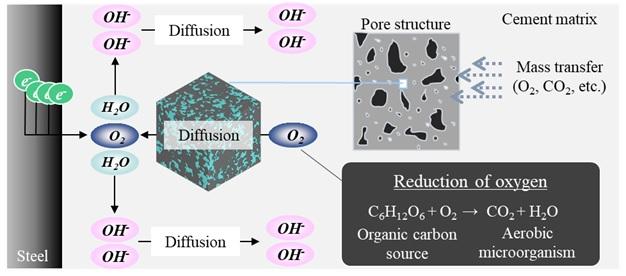
Credit: Ehime University
This study reports on a novel method for enhancing corrosion resistance via reduced availability of dissolved oxygen in the cathodic reactions which could be obtained through metabolic processes of aerobic Bacillus subtilis natto in the presence of organic carbon sources. In addition, the approach is beneficial in facilitating the formation of calcium carbonate which seals cracks accompanied by the self-healing of concrete.
Corrosion of steel bars in concrete leads to a decrease in the durability of reinforced concrete. The corrosion processes can be explained by electro-chemical reactions taking place in anodic and cathodic regions. The latter reaction requires oxygen and water, which is an electrolyte that can support the flow of electrons.
Dissolved oxygen in pore solution is often a controlling factor determining the rate of the corrosion process of steel bars in concrete. The properties are essentially associated with the permeability of dissolved oxygen in the pore solution. This could be affected by the metabolic activities of aerobic Bacillus subtilis natto mixed in cementitious mixtures. Bacillus subtilis natto is resistant to unfavourable environmental conditions, including salinity and extreme pH, through the formation of an endospore at times of nutritional stress until conditions become favourable.
Electro-chemical measurements were carried out to examine the corrosion processes by the AC impedance method, half-cell potential measurements, and macrocell corrosion measurements using zero-resistance ammeters. Cathodic polarization curves were measured at 28 and 91 days before and after the specimens were exposed to chloride induced corrosion tests through dry and wet cycles.
The results indicate that the rate of oxygen permeability inferred based on limiting current density is substantially lower in the case of mortar specimens mixed with the Bacillus subtilis natto. This can be explained by the fact that the dissolved oxygen is consumed by the oxidation of organic matter, a process initially catalyzed by Bacillus subtilis natto present in mortar mixtures during the monitoring periods. Based on the results obtained, the addition of a culture solution containing Bacillus subtilis natto reacting with dissolved oxygen resulted in higher resistance against corrosion processes, which was confirmed by the results of half-cell potential and microcell and macrocell corrosion current density. There is a strong possibility that the reduced dissolved oxygen in the pore solution through the aerobic processes could enhance corrosion resistance in cracked mortar specimens.
###
Media Contact
Public Relations Division
[email protected]
Original Source
https:/
Related Journal Article
http://dx.




